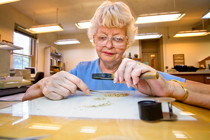RESEARCH SPOTLIGHT
Diagnostic labs analyze anything from bugs to toenails

Clinic director Karen Snover-Clift and diagnostician Sandra Jensen, foreground, view rust pustules through a microscope that not only takes pictures but projects images on a screen and has an IP address so experts can view from anywhere with an Internet connection. See larger image
Found an odd bug in your closet? Rhododendrons inexplicably wilting? Need a toenail analyzed? There's a lab for that.
Cornell's College of Agriculture and Life Sciences is home to several diagnostic centers that analyze scientific samples and those sent in by citizens.
For $25, anyone can send their mystery bugs to Jason Dombroskie, director of the Insect Diagnostic Lab. Sometimes he can make an identification from a digital photo; others require a full-on dissection.
Homeowners, farmers and pest control companies are common customers among Dombroskie's average of five insect identifications per week. In one case, Dombroskie's analysis of plaster beetles from a woman's closet led to identifying not only the insect, but a mold problem. In another, he's helping find the source of insects squished in plastics manufactured by a company in Norway.
This summer, Dombroskie worked with New York state to monitor for various potential problem pests, including the light brown apple moth – a "huge pest" in California that is notoriously difficult to identify and also the subject of his Ph.D. dissertation.

A testing method is used to process samples for plum pox virus in New York's stone fruit orchards. See larger image
At the Plant Disease Diagnostic Clinic, specialists analyze about 600 plant samples a year for researchers, extension associates, homeowners, arborists and golf course managers.
The Forest Service and New York State Department of Agriculture and Markets are big customers, and their samples sometimes drastically increase the clinic's workload, as when the plum pox virus first made an appearance in the region.
"The year we found it for the first time in New York state, we went from 15,000 to 65,000 samples in a few weeks," said clinic director Karen Snover-Clift. After the terrorist attacks of Sept. 11, 2001, Cornell's diagnostic clinic was also tapped to become a regional center in the federal government's efforts to protect the nation's food supply. Since 2002, whenever a National Plant Diagnostic Network member laboratory diagnoses a plant pathogen or pest, they send their identification to a national repository.
"The objective is to have this national network of experts all looking for certain pathogens, and when new things come in, we're alerted to that," Snover-Clift said.
So far, there have been no intentional attacks on the food supply, but the national repository has proven tremendously useful in spreading the word about newly introduced pathogens, such as boxwood blight and Japanese apple rust, Snover-Clift said.

Joyce Wicksall, a purity analyst at the New York State Seed Testing Laboratory at the New York State Agricultural Experiment Station, has worked at the Geneva facility for more than half of its 100-year history. See larger image
The Cornell Nutrient Analysis Laboratory has the most varied samples of all: from toenails and hair to mushrooms, lemons, ink, cement, wine and nearly anything else you could think of.
Its most common analyses are soil, plants and water. The lab can offer a dizzying array of information on each sample. On soil, for example, most labs do a standard chemical test with information on nutrients, metals and acidity. The lab adds an assortment of physical and biological tests that gives a better picture of total soil health and allows farmers to maintain productivity without resorting to over-fertilization. Home gardeners curious about whether there's too much lead in their soil can also send in a sample and have it analyzed for just $14.
"The more parameters we can monitor and measure, the better we can increase agricultural production and minimize environmental damage," said lab director Michael Rutzke.
Lab specialists have helped an organic mushroom farm determine why its produce was sending customers to the hospital (high arsenic in the soil). They're helping North Dakota farmers figure out how to reduce cadmium in their wheat so they can export to Europe. They're testing Kenyan soil and plants to help a researcher learn more about children's nutritional status.
As for toenails, they and hair are the best indicators of long-term toxicity exposure, Rutzke said.
Krisy Gashler is a freelance writer for the College of Agriculture and Life Sciences.